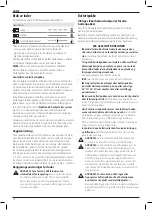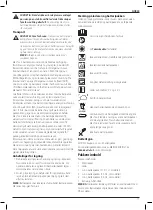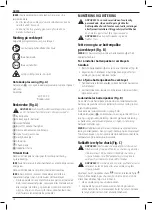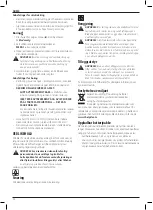
5
English
Safety Instructions for All Operations
•
Hold power tool by insulated gripping surfaces, when
performing an operation where the cutting accessory or
the fastener may contact hidden wiring.
Cutting accessory
or the fastener contacting a “live” wire may make exposed
metal parts of the power tool “live” and could give the operator
an electric shock.
Safety Instructions When Using Long
Drill Bits
•
Never operate at higher speed than the maximum
speed rating of the drill bit.
At higher speeds, the bit is likely
to bend if allowed to rotate freely without contacting the
workpiece, resulting in personal injury.
•
Always start drilling at low speed and with the bit tip
in contact with the workpiece.
At higher speeds, the bit is
likely to bend if allowed to rotate freely without contacting the
workpiece, resulting in personal injury.
•
Apply pressure only in direct line with the bit and do not
apply excessive pressure.
Bits can bend causing breakage or
loss of control, resulting in personal injury.
Additional Safety Warnings for Drills
•
Use clamps or other practical way to secure and support
the workpiece to a stable platform.
Holding the work by
hand or against your body is unstable and may lead to loss
of control.
•
Accessories and tool may get hot during operation.
Wear
gloves when handling them if performing heat producing
applications such as drilling metals.
•
Air vents often cover moving parts and should be
avoided.
Loose clothes, jewelry or long hair can be caught in
moving parts.
Residual Risks
In spite of the application of the relevant safety regulations
and the implementation of safety devices, certain residual risks
cannot be avoided. These are:
• Impairment of hearing.
• Risk of personal injury due to flying particles.
• Risk of burns due to accessories becoming hot
during operation.
• Risk of personal injury due to prolonged use.
SAVE THESE INSTRUCTIONS
Chargers
Mac Tools chargers require no adjustment and are designed to
be as easy as possible to operate.
Electrical Safety
The electric motor has been designed for one voltage only.
Always check that the battery pack voltage corresponds to the
d )
Store idle power tools out of the reach of children
and do not allow persons unfamiliar with the power
tool or these instructions to operate the power tool.
Power tools are dangerous in the hands of untrained users.
e )
Maintain power tools and accesories. Check for
misalignment or binding of moving parts, breakage
of parts and any other condition that may affect the
power tool’s operation. If damaged, have the power
tool repaired before use.
Many accidents are caused by
poorly maintained power tools.
f )
Keep cutting tools sharp and clean.
Properly
maintained cutting tools with sharp cutting edges are less
likely to bind and are easier to control.
g )
Use the power tool, accessories and tool bits, etc.
in accordance with these instructions, taking into
account the working conditions and the work to be
performed.
Use of the power tool for operations different
from those intended could result in a hazardous situation.
h )
Keep handles and grasping surfaces dry, clean and
free from oil and grease.
Slippery handles and grasping
surfaces do not allow for safe handling and control of the
tool in unexpected situations.
5) Battery Tool Use and Care
a )
Recharge only with the charger specified by the
manufacturer.
A charger that is suitable for one type
of battery pack may create a risk of fire when used with
another battery pack.
b )
Use power tools only with specifically designated
battery packs.
Use of any other battery packs may create
a risk of injury and fire.
c )
When battery pack is not in use, keep it away from
other metal objects, like paper clips, coins, keys,
nails, screws or other small metal objects, that can
make a connection from one terminal to another.
Shorting the battery terminals together may cause burns
or a fire.
d )
Under abusive conditions, liquid may be ejected
from the battery; avoid contact. If contact
accidentally occurs, flush with water. If liquid
contacts eyes, additionally seek medical help.
Liquid
ejected from the battery may cause irritation or burns.
e )
Do not use a battery pack or tool that is damaged or
modified.
Damaged or modified batteries may exhibit
unpredictable behaviour resulting in fire, explosion or risk
of injury.
f )
Do not expose a battery pack or tool to fire or
excessive temperature.
Exposure to fire or temperature
above 130 °C may cause explosion.
g )
Follow all charging instructions and do not charge
the battery pack or tool outside the temperature
range specified in the instructions.
Charging
improperly or at temperatures outside the specified range
may damage the battery and increase the risk of fire.
6) Service
a )
Have your power tool serviced by a qualified repair
person using only identical replacement parts.
This
will ensure that the safety of the power tool is maintained.
b )
Never service damaged battery packs.
Service
of battery packs should only be performed by the
manufacturer or authorized service providers.








































